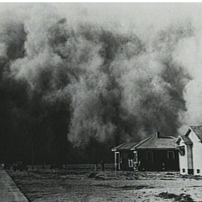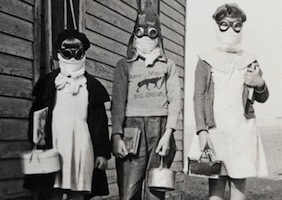Ken Burns' latest film: dust to dust -- and more dust
11/16/12 01:12 PM


By ED BARK
@unclebarkycom
Four hours worth of Ken Burns' The Dust Bowl might seem like too much to bear for even his most ardent fans.
But naw, they'll come around. Even while working up a powerful thirst.
The drought-stricken, spirit-sapping Great Plains of the 1930s get the lyrical and learned Burns treatment in a two-parter premiering on Sunday, Nov. 18th and concluding the following night (at 7 p.m. central on KERA13 in D-FW).
"It was a decade-long natural catastrophe of biblical proportions," says narrator Peter Coyote. And Dust Bowl has the striking stills and film to prove it -- over and over again.
Unlike the History network's oft-frenetic, slam-bang Mankind: The Story of All of Us, this is story-telling at a measured, meaningful pace. It might induce yawns in some younger viewers. But Burns has never been particularly concerned with audience demographics. His formula -- dating to The Civil War epic that put him on the map -- is to meld words and images to maximum effect without resorting to artificial abracadabra. And although Mankind has its share of awesome CGI-generated moments, Burns' beets overall are much better for you than the other guy's cotton candy.
Dust Bowl has the added advantage of eyewitnesses, all of whom were kids when their parents and grandparents found themselves battling the unrelenting elements in the heart of The Great Depression.
"Well, it was pretty bad," says Imogene Glover, who vividly remembers wearing dresses made out of flour sacks.
"We ate so poorly that the hobos wouldn't come to our house," says Clarence Beck.
The writings of Oklahoman Caroline Henderson, dubbed "The Homestead Lady," likewise resonate throughout the four-hour film. She and her husband, Will, stuck it out on their small farm. And many of her first-hand accounts made it to the pages of The Atlantic magazine.
The Dust Bowl's apex, where the strongest storms always seemed to hit, was the so-called "No Man's Land" in and around Boise City. Located in Oklahoma's thin western tip, it's bordered by Texas, Colorado, Kansas and New Mexico. You didn't want to be there a lot of the time in the "dirty thirties." But on "Black Sunday" -- April 14, 1935 -- the most horrific dust storm of them all finally sent some 25 percent of the area population packing off to California and other locales. It spawned the enduring Woody Guthrie song "So Long, It's Been Good to Know Ya," which is used to close out Sunday night's Part 1.
Virtually every Burns film has a moral. And in this case, nature struck back with unprecedented fury only after the soil had been despoiled by a wave of incoming, mostly dirt poor farmers seeking prosperity. They specialized in growing wheat during boom times for the crop. And a new method of tractor ploughing pounded the previously abundant grassland into submission. The winds then had their way, turning the defenseless dirt into massive black blizzards. Livestock were defenseless and humans, particularly children, became susceptible to "dust pneumonia."
Still, many stuck it out. They were resilient, stubborn, foolish and often without the wherewithal to simply pack up and leave. This was their home, after all, with its occasional blue skies or precipitation holding the promise of a new day and an end to the abundant misery.
Pictures tell these stories better than many of Dust Bowl's spoken words. A little boy traces traces the outlines of a house through dirt on the family's dining table. Gargantuan dust clouds loom in the background before turning day into pitch black. Rampaging, starving, crop-destroying jackrabbits are clubbed to death by the thousands. In one incredible piece of film, they're stacked into a huge pile of corpses in a manner similar to the mass Nazi atrocities during the Holocaust.
Dust Bowl also underscores the inescapable fact that federal government assistance helped to save the day for many. President Franklin Delano Roosevelt did not turn his back on the Plains, as some of his advisors said he should. Instead his Works Progress Administration created jobs for many of the up-against-it breadwinners. Farmers also were taught a deeper, better but slower form of "contour" plowing that greatly helped to curb erosion.
"To us he was a saviour," says Virginia Frantz. "He gave us hope where there was none."
For many proudly independent farmers, asking for any form of federal aid was an absolute last resort. But ask they eventually did. And they received.
Monday's Part 2 includes a near-magical picture of FDR, whose triumphant visit to Amarillo near the end of the 1930s drew a crowd of more than 200,000 in addition to a "World's Largest Marching Band" assembled for the occasion. A downpour erupted during the president's speech, with a front page picture the next day showing him beaming with approval in a rain hat.
This is what Burns has always done best. Find a story worth re-telling. Illustrate it with images that keep speaking to us. And perhaps proselytize a little along the way.
In this particular case, Dust Bowl sings the praises of government intervention in times when doing nothing would have been inhumane. In one ravaged county, 80 percent of the population ended up receiving some form of federal assistance.
"When your back is against the wall, all ideology goes out the window," says historian Donald Worster.
That currently holds true with Hurricane Sandy, which took just a day to devastate the Jersey Shore. The Dust Bowl, in contrast, was a decade in the making -- and is now three quarters of a century behind us. That's where Ken Burns steps in. And his films continue to leave lasting footprints.
GRADE: A
unclebarky@verizon.net
